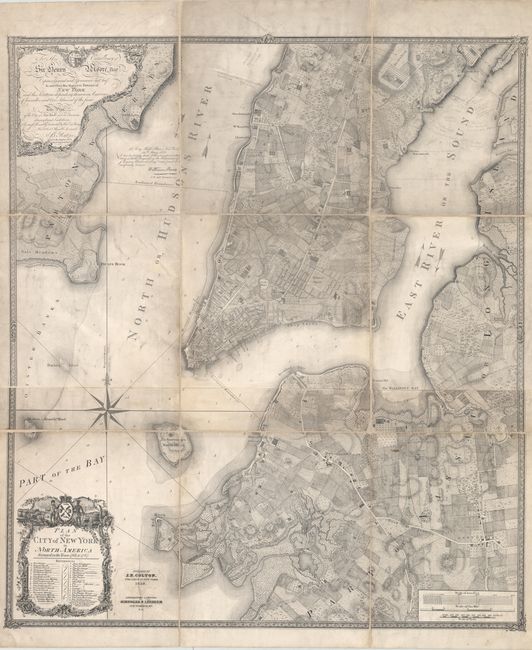Subject: New York City, New York
Period: 1853 (dated)
Publication:
Color: Black & White
Size:
35.3 x 40.2 inches
89.7 x 102.1 cm
This is Joseph Hutchins Colton's rare edition of the Ratzer map of New York City, described by Augustyn and Cohen as "perhaps the finest map of an American city and its environs produced in the eighteenth century." Lieutenant Bernard Ratzer was a military engineer deployed in America during the French and Indian War as part of the Royal American Regiment. Along with cohorts such as Samuel Holland, C.J. Sauthier, and John Montresor, Ratzer had a technical approach to mapping that had been missing in early American cartography. From late 1766 to early 1767, Ratzer expanded upon Montresor's surveying of Manhattan, extending its scope and adding street names and wards. The "Ratzen Plan" (its name based on the misspelling of the surveyor's name), dedicated to Sir Henry Moore, the governor of New York, was published circa 1769 and again in 1776 by Faden and Jefferys. In the latter part of 1767, Ratzer continued to survey Manhattan and its surroundings, capturing the topography of the region in stunning detail. The results of this survey were published circa 1770 as the so-called "Ratzer Map," with a view of the city from Governor's Island running across the bottom. After an unsuccessful initial publication, this map was published again in 1776 by Faden and Jefferys.
Colton's edition is based off the latter map, without the view. A note indicates that it was copied from an original example in the collection of J. Carson Brevoort, a noted Brooklyn-based collector of rare books and coins. It depicts Manhattan as far north as present-day 50th Street and extends into Brooklyn, Queens, and part of New Jersey, which were still rural areas at the time. On the eastern coast of Manhattan, three Stuyvesant estates are identified. Today's Greenwich Village is here called Oreenwich. On the West Side, the property of Captain Thomas Clarke is located; his estate, named Chelsea after the London veterans hospital, gives the contemporary neighborhood its name. The map features excellent detail of streets and roads, even noting country lanes and estate roads. Collect Pond, here called Fresh Water, is shown in the process of being filled in. Developments around Delancy's Square replace the swampland that appeared on Montresor's earlier map.
An ornate cartouche featuring the dedication to Governor Moore and the imprint of engraved Thomas Kitchin dominates the top left corner of the map. The decorative title cartouche at bottom left incorporates the New York City seal, with a colonist and Native American flanking a shield with four windmill sails, two flour barrels, and two beavers. It also includes a key that identifies 35 sites of interest. Lithographed and printed by Schedler and Liebler. Issued dissected and mounted on linen.
References: cf. Augustyn & Cohen (Manhattan) pp. 73-77.
Condition: B+
The map is dissected and has been professionally re-backed with new linen. It has light to moderate soiling, manuscript notations in pencil, and some small abrasions in the publisher's imprint that have been expertly replaced in facsimile. The map's left and right margins extend beyond the scanner bed's maximum width; on the actual map the left margin measures 1" and the right margin measures 2.3".


